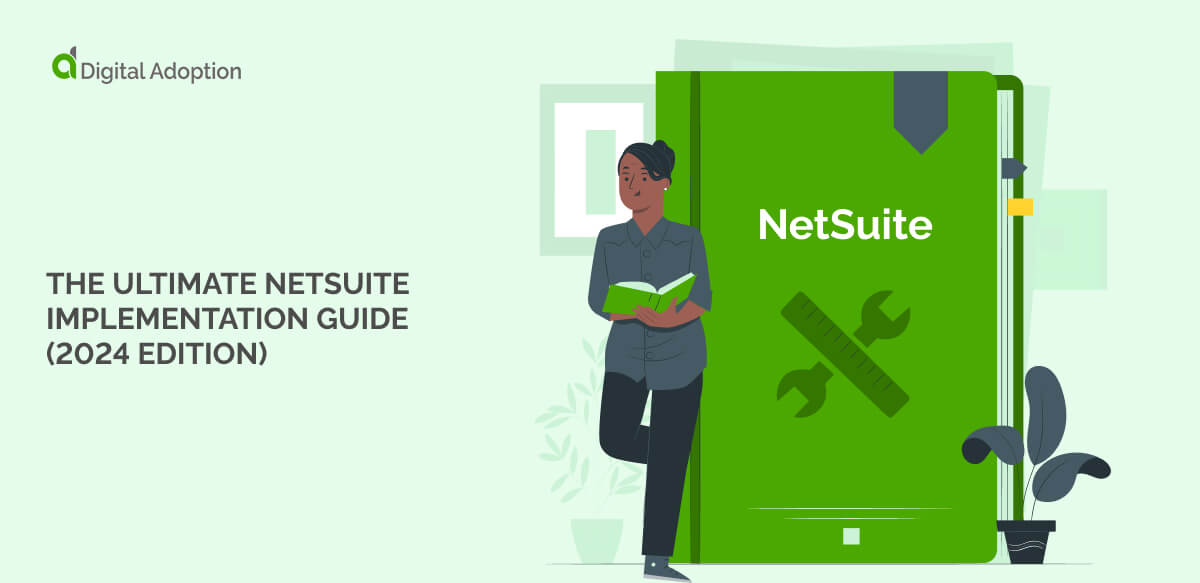You might be a new business looking to adopt your first Enterprise Resource Planning (ERP) software.
Or perhaps you’re a larger business switching from your existing ERP to a more digital solution like NetSuite.
The ever-changing landscape of NetSuite makes it difficult to keep up with best practices for implementation. Furthermore, as digital transformation goes, adopting NetSuite can be particularly challenging.
That’s why we’ve compiled this guide to NetSuite implementation methodology with updated information.
We will explain what NetSuite is, why it’s so difficult to implement, and everything you need to consider before you pull the trigger and kick off your own NetSuite ERP implementation.
Following the advice in this guide will help you guarantee successful digital adoption.
What Is NetSuite?
NetSuite is an all-in-one ERP solution to help businesses manage their operations from one centralized platform.
You might have heard of NetSuite because it is by far the most widely used ERP.
NetSuite has an extensive list of features, including:
- Financial planning and analysis
- Customer relationship management (CRM)
- Inventory management
- Order management
- E-commerce solutions
It’s a great solution for enterprises that require multiple systems integrated into one platform with open APIs to enable customization.
Since NetSuite is a cloud-based solution, it also can be scaled quickly if your business grows rapidly.
NetSuite is used by many large businesses due to its robustness and scalability, making it a great choice for any business looking to digitally transform its operations.
What are the Challenges of NetSuite Implementation?
While there are many benefits to using NetSuite, the main challenge lies in the initial implementation.
NetSuite implementation projects can be lengthy and require a significant investment of both time and resources.
For a new business with no need to migrate data, successful NetSuite implementation could take as little as three months.
For bigger businesses, a NetSuite implementation project could take several months longer, even with dedicated teams, external support, and a robust implementation methodology.
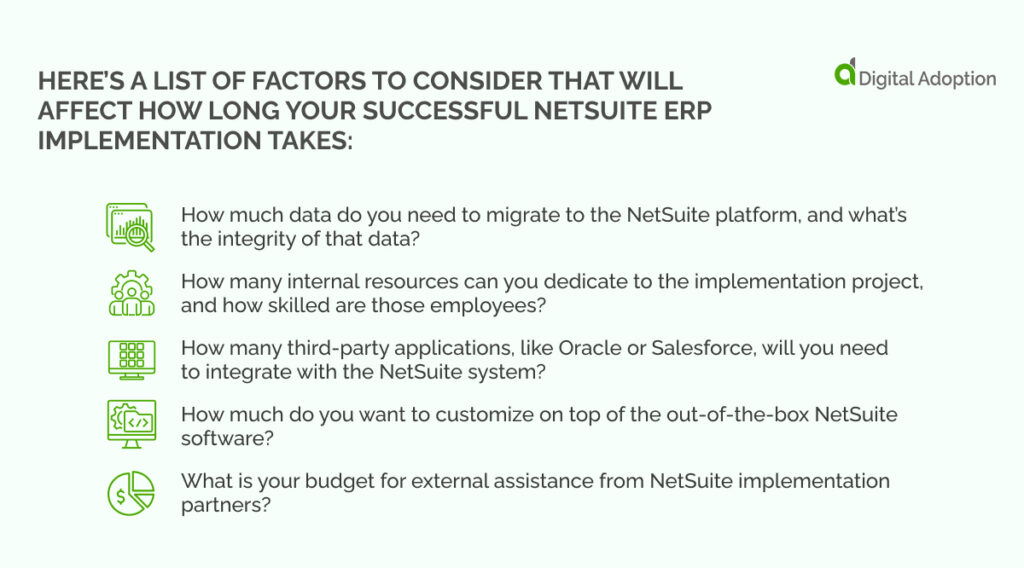
Here’s a list of factors to consider that will affect how long your successful NetSuite ERP implementation takes:
- How much data do you need to migrate to the NetSuite platform, and what’s the integrity of that data?
- How many internal resources can you dedicate to the implementation project, and how skilled are those employees?
- How many third-party applications, like Oracle or Salesforce, will you need to integrate with the NetSuite system?
- How much do you want to customize on top of the out-of-the-box NetSuite software?
- What is your budget for external assistance from NetSuite implementation partners?
On top of that, NetSuite is constantly being updated. On the one hand, this is a positive— it makes improving business operations easier after you implement NetSuite.
On the other hand, you may need to dedicate some internal resources to keeping your NetSuite implementation up to date indefinitely.
3 Options for NetSuite ERP Implementation
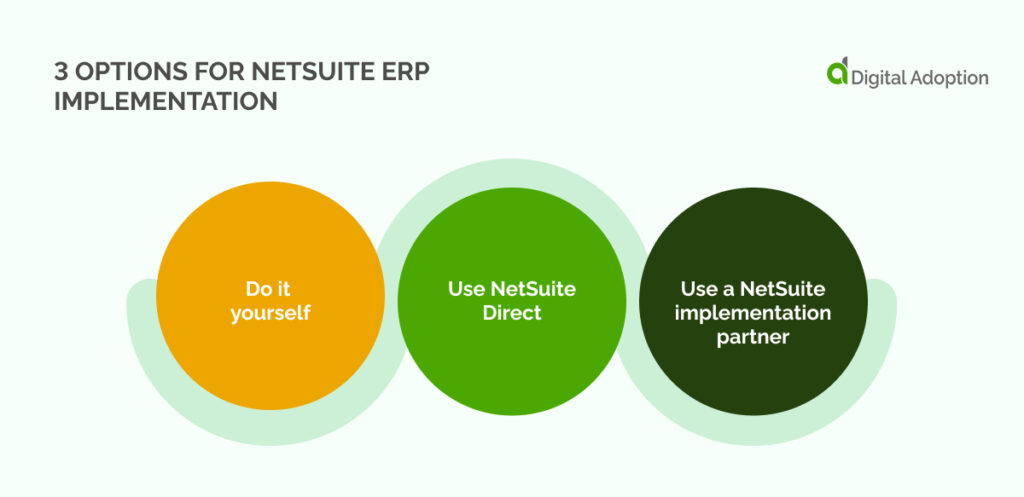
The first decision you’ll need to make is whether you will seek assistance from a NetSuite implementation consultant and how much.
In this regard, you have three choices:
- Do it yourself
- Use NetSuite Direct
- Use a NetSuite implementation partner
Let’s take a closer look at the pros and cons of each of these choices.
Option 1: Do It Yourself

Naturally, this is the cheapest option that affords you the most control as you implement NetSuite.
However, it’s not realistic for most businesses.
Implementing NetSuite software yourself is only feasible if you have experience architecting similar solutions.
Additionally, you’ll need an expert ERP implementation team who will need to be removed from their primary roles, probably through secondment, for the duration of the NetSuite implementation process.
Consider whether the cost of backfilling the implementation teams’ old positions and the extra hassle of organizing the whole project yourself is worth the cost saving.
Option 2: Use NetSuite Services
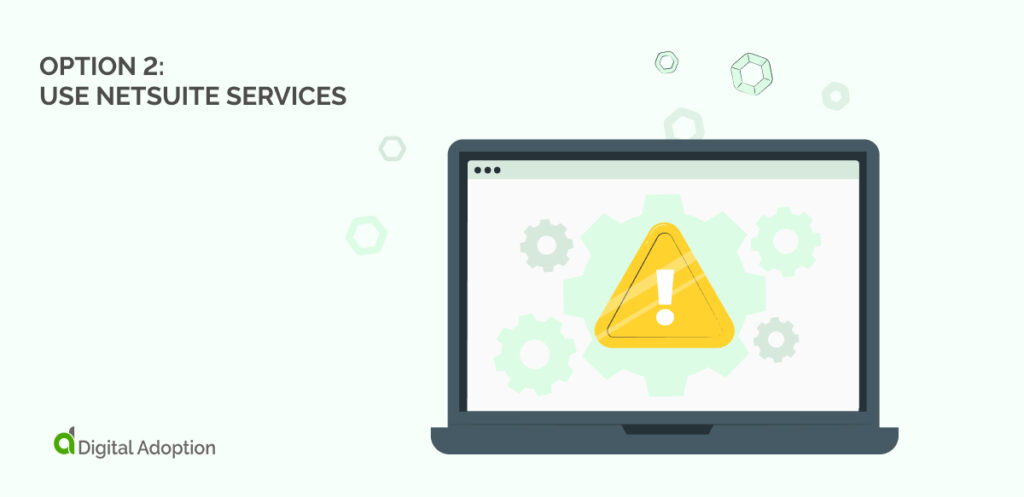
NetSuite has internally trained teams of NetSuite consultants who can help you through the implementation steps.
They call this “NetSuite Services.”
Using official NetSuite consultants guarantees they’ll have in-depth expertise in the product, but there is a drawback: If you want to make a lot of NetSuite customizations, this might not be the best choice.
While NetSuite’s team knows the out-of-the-box product better than anyone, there might be an external NetSuite implementation partner who better understands the NetSuite customizations you may want to make.
Use a NetSuite Implementation Partner
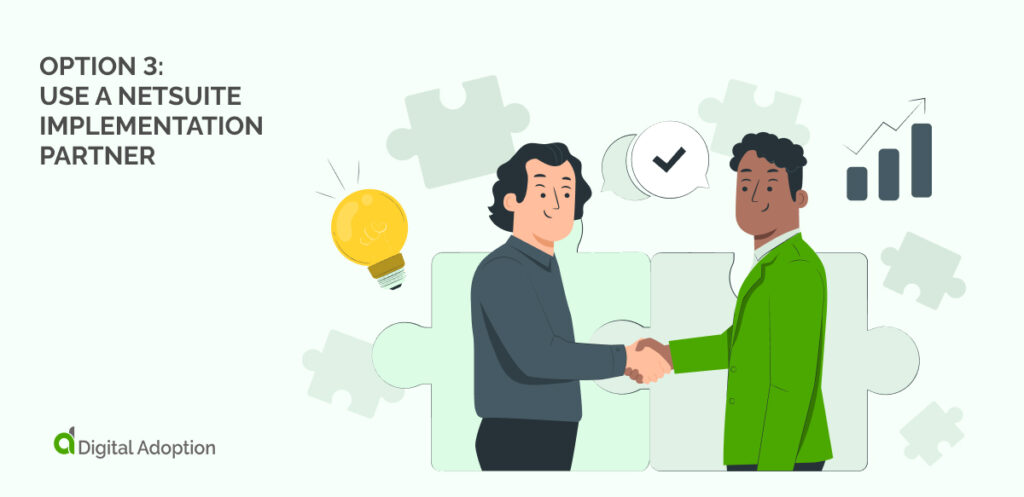
If you have a specific idea that differs from the out-of-the-box NetSuite platform, finding a specialized NetSuite consultant might be the best route.
These contractors have deep experience with more specific and niche elements of how NetSuite works. They can also offer other services, like post-go-live support and employee training.
The main drawback of using a NetSuite partner is that you’ll have a higher NetSuite implementation cost. Depending on the complexity of your project scope, you may need to pay for more contract hours from your chosen NetSuite partner than if you had gone with NetSuite Services.
The Stages of a Successful NetSuite Implementation:
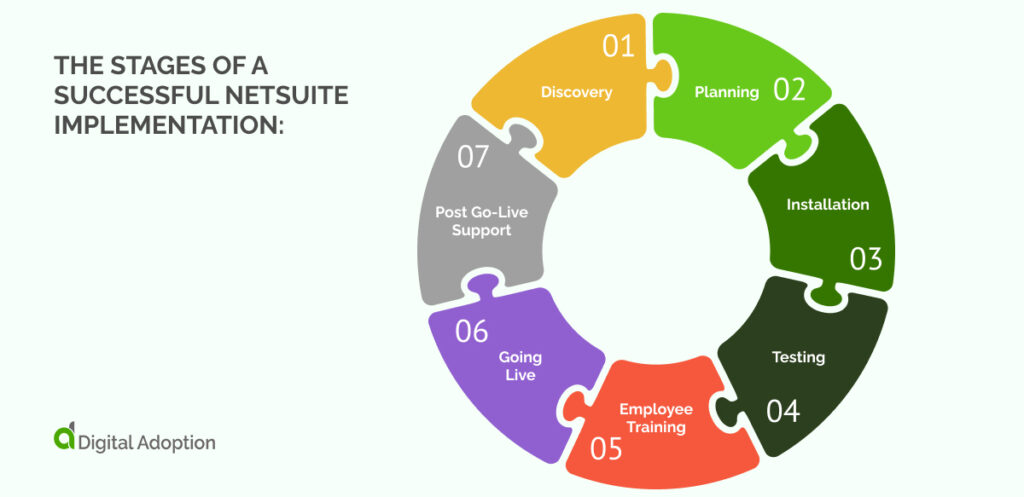
Now that you know more about the different options for implementing NetSuite, let’s dive into the nitty-gritty of this implementation guide.
Discovery
This phase includes developing a deep understanding of your business’s needs. Since NetSuite permeates so many business functions, it’s important to consider business and user needs across as many functions as possible.
Look for problems in the business that NetSuite could solve. Look also for issues that NetSuite could create. This is called a NetSuite gap analysis, which a NetSuite partner can help you with.
Planning
During this phase, you’ll create a detailed NetSuite implementation timeline and outline your project scope.
This includes budgeting. NetSuite can be a timely and expensive implementation, and it can take even more time to realize a return on investment. For this reason, it’s critical that you lay out and stick to a budget to avoid any nasty surprises from your NetSuite implementation cost.
You should also make change management preparations. NetSuite implementation can be a major digital transformation, and following good change management practices will increase the odds of a smooth, seamless transition.
Installation
Your NetSuite environment is created and configured according to your exact specifications. Any customizations or integrations will be set up now.
During this phase, you may also have to migrate data.
Before data migration, you should assess and cleanse your data. Clean, organized, pared-down data will simplify the data migration process. You can begin this process anytime, and doing it early could significantly move up your NetSuite implementation timeline.
Delete any data you don’t need. Archive any data you’re not using. Hitting the ground running with good data lifecycle management will pay dividends.
Testing
The first round of the testing process will be to ensure everything works as it should and that there are no errors or bugs in the system. Developers should carry out this degree of testing throughout the implementation process.
Once the system is set up satisfactorily, the implementation team should take some sample use cases defined in the Discovery phase and run them through NetSuite. This will help to iron out kinks, define new business processes, and give the team insight into the user experience.
After that comes user acceptance testing (UAT), where users will test out the implementation, this just takes the benefits of testing a little further— ironing out more kinks and giving more insight into the user experience.
Employee Training
The goal here is to ensure your employees know how to use NetSuite effectively so they can work with it daily without too much effort.
Delivering effective employee training is critical to successful digital transformation. Employees who aren’t comfortable with the new systems will resist them.
When trying to make major digital changes, it helps not to fight against your workforce, so don’t underestimate the importance of the training phase.
Going Live
It’s show-time! You can officially launch your new digital ERP. Consider keeping old and new systems running concurrently for a short time to ease the transition process.
Don’t sit back just yet, though— we’re not done.
Post Go-Live Support
No digital transformation on this scale is complete after it goes live.
There will be issues even if you’re diligent throughout the implementation process. You’ll need to be prepared to adjust and tweak business processes and deal with major issues.
You’ll need to continue to train users, and you’ll need to prepare an ongoing process to deal with future NetSuite updates.
Additional Best Practices for NetSuite Implementations
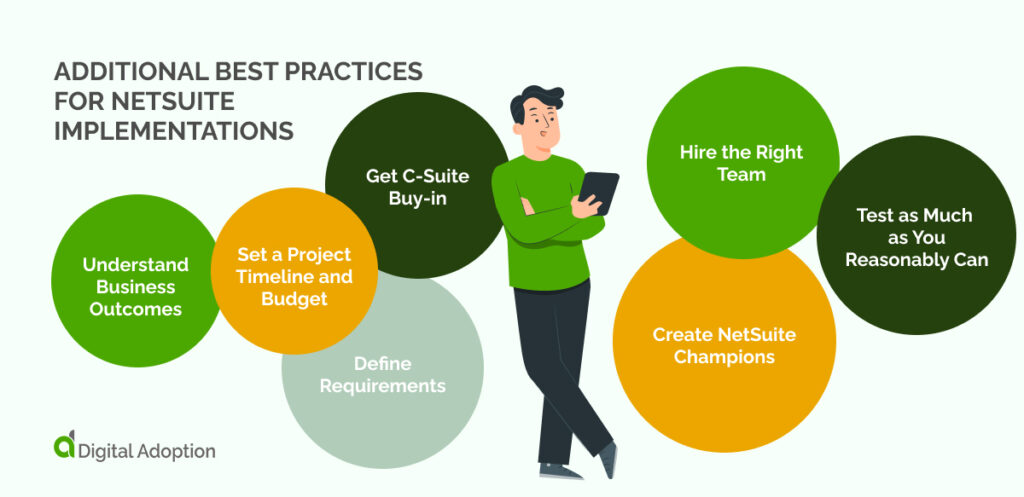
Every NetSuite implementation is different, presenting unique challenges to overcome.
But, we think this list of best practices is generally applicable. Think about which ones you want to take forward in your NetSuite implementation.
Understand Business Outcomes
Think about what specific measures you can use to see how NetSuite benefits your business. Will it result in increased efficiency within specific processes? Increased profits in another?
Here’s a top tip: Relate every outcome to monetary value. The bottom line is cash is king in business.
Define these changes as short, concise statements. These are your business outcomes, and they’ll help you communicate the change in your organization.
Get C-Suite Buy-in
Secure buy-in from the C-suite for your NetSuite project early on. This will help the project gain momentum and ensure the support and resources needed for a successful implementation.
Change has to happen from the top down. You can expect some of your employees to resist the changes you’re about to implement.
Having the entire leadership team on side will go a long way to mitigate this.
Define Requirements
The more detailed a list of requirements you can create, the better. NetSuite is highly customizable, and nobody understands your business better than you, so it’s on you to call the right shots.
If you’re in a specific industry that has custom NetSuite business requirements, you’ll need to be able to communicate them effectively to your project team. This is critical in achieving maximum ROI.
However, thinking about what you don’t need is just as important.
Taking on additional capabilities that you don’t need is a money sink. Overly complex solutions will see a backlash from employees.
There’s a lot to be said for keeping it simple.
Set a Project Timeline and Budget
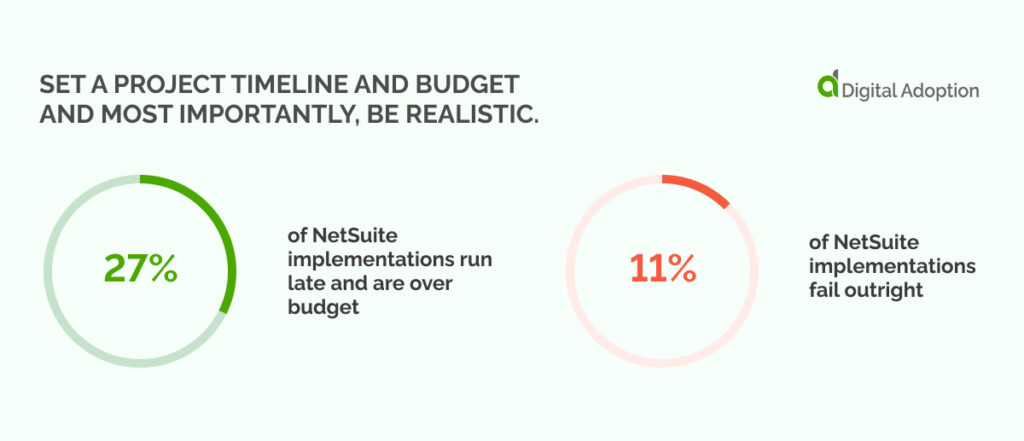
And most importantly, be realistic.
27% of NetSuite implementations run late and are over budget. 11% of NetSuite implementations fail outright.
Give yourself some wiggle room regarding both timeline and budget, if possible. NetSuite implementations can be messy if you try to take shortcuts or cut costs.
You can do this without relying on expensive external contractors, but it isn’t easy. Carefully consider your best option.
Hire the Right Team
We trust you to hire capable people if you’re using an internal implementation team. But you must also consider that you’ll take them away from their primary roles for months.
Communicate this clearly, and ensure there’s a place for them to return to once the implementation is complete.
If you instead opt to work with a partner that isn’t NetSuite Services— do some shopping around.
Search for a partner that understands your business outcomes and perhaps has experience working with clients in your industry.
You will likely be working with them for months, so do what you can to make it a painless experience.
Create NetSuite Champions
In addition to your actual implementation and training teams, consider allocating “NetSuite Champions” tactically among your employees.
These should be employees who can advocate for the platform, provide support and advice, and encourage adoption within the organization.
Get the champions involved as early as possible. Most of their work will come post-go-live, but there’s no reason they can’t be part of earlier conversations.
Creating champions is a great way to engage employees in something new and develop a change-friendly culture in your organization. Don’t forget to think about what benefits you can offer to change champions for the extra responsibilities they’re stepping up to.
Test as Much as You Reasonably Can
When you’re so close to the finish line, it can be tempting to sprint to complete the implementation ahead of the timeline and under budget— oh, how you could brag!
Don’t misstep, though. Go-live is not the finish line.
Test as much as you can before you go live. Data you glean from testing feeds directly into your post-go-live support.
The more you test, the more you can anticipate potential problems and snags. The more you can predict user questions, the more successful your NetSuite Implementation will be.
What’s the Ideal Time to Start Your NetSuite Implementation Process?

As the proverb goes:
“The best time to plant a tree was 20 years ago. The second-best time is now.”
NetSuite has been the industry standard cloud-based ERP for quite some time and isn’t getting any simpler.
To that point, neither is your business.
As time goes on, businesses usually grow bigger and more complex. They grow more ingrained, rooted in their ways. The longer you leave a business process in place, the harder it is to uproot.
Transitioning to a highly digital solution like NetSuite is hard, but it opens the door to faster, easier digital transformation.
ERP implementation is a months-long process, but the first step is the theoretical, exploratory analysis, which costs very little.
When you think of it that way, it seems logical to start planning your NetSuite software implementation immediately.
Wouldn’t you agree?

